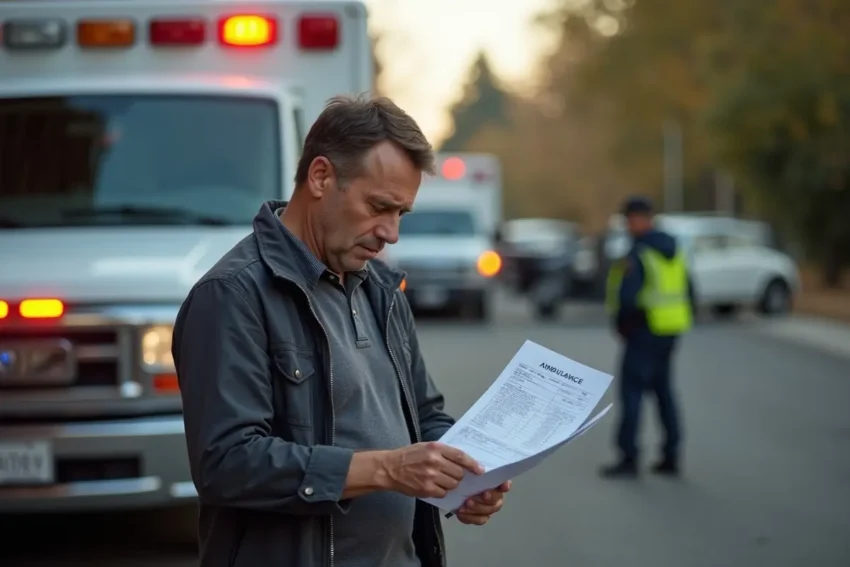Navigating the aftermath of an accident can be overwhelming, especially when faced with unexpected bills, such as a direct charge for ambulance services. Understanding your rights and responsibilities is crucial to managing these unanticipated financial burdens. Whether you’re looking for a Wichita truck accident attorney, this article will guide you through the steps to take if you’re billed directly for an ambulance after an accident.
Understanding Your Ambulance Bill: What It Covers
Basic Components of an Ambulance Bill
When you’re directly billed for an ambulance service, understanding what you’re paying for can be crucial. Ambulance bills typically encompass several components. Firstly, there’s the base rate, which covers the cost of dispatching the ambulance. This fee ensures the readiness and availability of emergency medical services when you need them most.
Additional Costs and Services
Beyond the base rate, your bill may include mileage charges, which reflect the distance the ambulance travels during the service. If special medical attention or equipment were required en route, such as oxygen or advanced life support, these services are itemized separately. Each element of your care, from the personnel to the technology used, contributes to the overall cost. Understanding these details can help you navigate potential disputes or discussions with your insurance provider.
Why You Might Be Billed Directly for an Ambulance
Insurance Coverage Limitations
Understanding the nuances of insurance coverage is critical when deciphering why you might receive a direct ambulance bill. Insurance policies vary significantly, with some only covering a portion of emergency transport costs. If your policy has limited coverage, you may be responsible for any remaining balance. It’s also possible that your insurance doesn’t include ambulance services at all, leaving you with the full expense.
Geographical and Provider Factors
Another reason for direct billing could be geographical and provider factors. Ambulance services across different regions are often managed by a variety of providers, each with distinct billing policies. If an ambulance service is deemed out-of-network by your insurance, this can result in direct billing. Additionally, the distance traveled and the level of care provided en route can further influence costs.
Administrative Errors
On occasion, administrative errors during the billing process can result in unexpected charges. Errors in insurance claim submissions, incorrect patient details, or miscommunications between the ambulance provider and your insurer can result in a direct bill to you. It’s essential to review your bill carefully and contact both your provider and insurer promptly to rectify any discrepancies.
Steps to Take if You’re Billed Directly for an Ambulance Accident
Verify the Billing Details
First, carefully examine the bill to ensure that all charges are accurate. Confirm that your insurance information was provided at the time of service. If any details appear incorrect, contact the billing department promptly to rectify the issue.
Contact Your Insurance Provider
Contact your insurance company to discuss the charges. Provide them with the necessary documentation and inquire if the ambulance services should have been covered under your policy. This step is crucial, as insurance may cover more than you expect.
Negotiate Payment Terms
If insurance coverage is insufficient, negotiate with the ambulance service provider. Many offer payment plans or may lower the bill if financial hardship is demonstrated, easing the financial burden on you.
How to Dispute and Negotiate Your Ambulance Bill
Gather the Right Information
Start by collecting everything related to your ambulance bill. Keep the original bill, any letters or emails from the ambulance company, and your insurance paperwork. Look closely at your insurance plan to see what’s covered and what you might have to pay yourself.
Contact the Ambulance Company
Reach out to the billing department and ask about anything on the bill that doesn’t make sense. Request an itemized statement so you can see exactly what each charge is for. Don’t hesitate to question anything that looks wrong.
Work Out Payment Options
If the bill is correct but too expensive to pay all at once, ask about alternatives. Many ambulance companies will set up payment plans or even lower the cost if you’re having financial difficulties. Be upfront about your situation and share proof if needed. Staying persistent often helps you find a payment arrangement you can handle.
Insurance and Ambulance Bills: What You Need to Know
Understanding Coverage
Insurance policies can feel overwhelming, but knowing what your plan actually covers makes a big difference. Most health insurance plans include ambulance services, but the details aren’t always the same. Some only pay for emergency transport, while others might ask for pre-approval. The best way to avoid surprises is to go over your policy carefully and pay attention to the fine print.
What to Do if You’re Billed
If an ambulance bill shows up, start by calling your insurance company. Make sure the claim was handled correctly; sometimes mistakes happen because of coding errors or miscommunication. If your claim is denied, you still have options: you can appeal the decision or work out a payment plan with the ambulance provider to help manage the cost.
Final Thoughts
In navigating the complexities of medical billing, particularly when unexpectedly charged for ambulance services, your proactive engagement is paramount. Whether you are looking for a Wichita truck accident attorney, familiarizing yourself with insurance policies, promptly contacting providers, or diligently documenting all communications, these steps can help mitigate financial stress and ensure clarity. Moreover, understanding your rights and exploring available assistance programs can provide substantial relief.

